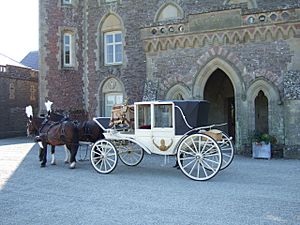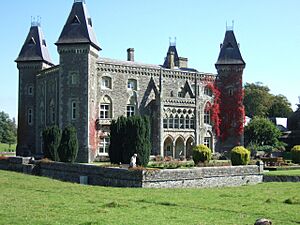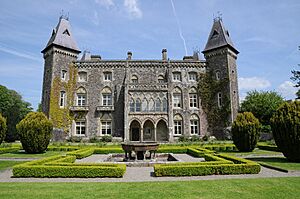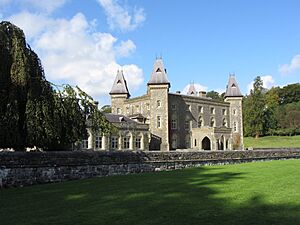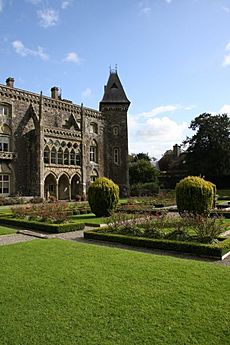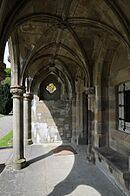Newton House, Llandeilo facts for kids
Quick facts for kids Newton House |
|
|---|---|
| Plas Dinefwr | |
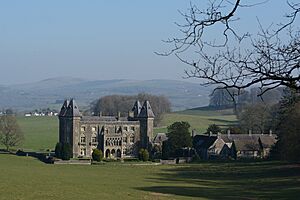 |
|
| Type | House |
| Location | Llandeilo, Carmarthenshire |
| Built | 1660 |
| Rebuilt | 1850 |
| Architectural style(s) | Victorian gothic |
| Owner | National Trust, Davies Family |
|
Listed Building – Grade II*
|
|
| Official name: Plas Dinefwr | |
| Designated | 1966 |
| Reference no. | 11098 |
| Lua error in Module:Location_map at line 420: attempt to index field 'wikibase' (a nil value). | |
Newton House is an old country house near Llandeilo in Carmarthenshire, Wales. It is partly owned and cared for by the National Trust. The house sits inside Dinefwr Park and near Dinefwr Castle. The park and gardens are very important historically.
People have lived on this spot for over 2,000 years. The first house was built here a long time ago, in the Middle Ages. The house you see today was built in 1660 by Edward Rice. It was built in the Jacobean style. Later, in the 1850s, it was changed a lot to look more like Venetian Gothic buildings.
Newton House was part of the Rebecca Riots in 1843. At that time, Colonel George Rice-Trevor, who lived there, received a scary warning. The house faced tough times after 1956. It was sold in 1974 and became run down. The National Trust and Cadw have since restored it.
The house is a three-story building made of grey stone. It has four tall towers at each corner and sloping slate roofs. The front has a large central entrance. You can visit two rooms, a tearoom, and an exhibition. These areas show the history of the house and its past residents. The deer park around the house was designed by Capability Brown in 1775. Newton House is also known as one of the most haunted houses in Wales. People say they can smell tobacco smoke from Walter the Butler, a ghost who used to work there.
Contents
History of Newton House
Dinefwr Park has been used by people for at least 2,000 years. A stone axe from the Stone Age was found here in 1976. During the Iron Age, there was a farm on the land. The Romans later built two forts here. You can still see traces of old Roman roads. Roman coins and pottery have also been found near Dinefwr Castle.
In the 12th century, Rhys ap Gruffydd, the Prince of Wales, built Dinefwr Castle. King Henry VIII took over the castle and land in 1531. The Rice family, who owned the estate, had to buy their property back. They later became known as the Barons Dynevor. The family fully got their lands back during the time of King Charles I.
Newton House was first built in the Middle Ages, away from the castle. It was changed in 1595 and 1603. The current Newton House was finished in 1660 by Edward Rice. In the late 1700s, George Rice and his wife Cecil started a beautiful garden. They hired a famous designer, Capability Brown, in 1775. Towers and battlements were added between 1760 and 1780. This made the house look more romantic. During the Rebecca Riots in 1843, Colonel George Rice received a warning. An empty grave was dug in the grounds to scare him.
Newton House went through a difficult time after 1956. The owners died within a few years. Much of the estate had to be sold. In 1974, the property was sold again. It became very run down. People who shouldn't have been there took parts of the house and furniture. The National Trust bought the deer park in 1987. They bought Newton House three years later. Both the house and Dinefwr Castle have been restored.
Architecture and Design
Edward Rice started building the Jacobean house in 1659. It was finished the next year. Towers and battlements were added between 1760 and 1780. Around 1856, big changes were made in the Venetian Gothic style. This gives the house a Victorian feel today. The National Trust says that most of the grand building you see now is from the 1850s. It got a stylish Gothic makeover with stone and four impressive towers. Newton House is a very important historical building. Other nearby buildings like the summer house and dairy cottage are also listed for their history.
Newton House has three stories and is built from grey stone. It has a tall tower at each corner and sloping slate roofs. The front has a large central porch. The ceilings from the late 1600s are very special. They have thick molded beams and designs of flowers and cherubs. The entrance hall has old columns. The old dining room has a ceiling from the 1600s with detailed patterns. The drawing room also has a richly decorated ceiling. The staircase from the 1600s has thick railings and carved designs. A billiard room was added in 1896. A strongroom with thick walls was added in 1914. This was to keep important documents safe. The upper floors have rooms with designs from the 1700s.
The house has several important paintings. These include Mary, Queen of Scots Bidding Farewell to France by William Powell Frith. There is also a portrait of Bishop William Talbot by Godfrey Kneller. Two rooms are open to the public. Besides the tearoom, there is an exhibition. It shows the history of the Rhys family and the estate. It is set up to look like the year 1912.
Park and Gardens
The house is surrounded by a deer park. This park was designed starting in 1775. It has winding paths and trees placed to frame the house and castle. The deer park is home to rare White Park cattle and fallow deer. A small garden behind the house has been restored. It has a fountain and overlooks the deer park. The park is a very important historical garden in Wales.
In 1862, Benjamin Clarje wrote that the park had "perhaps a richer display of varied landscape than any spot of similar size in the kingdom." He noted that the upper part of the park had gentle hills and beautiful trees. The River Towy flows nearby. The Wildlife Trust West Wales bought the nearby woodland in 1979.
Peter Crawford wrote about the park in his book, The Living Isles. He said the woodland is mostly oak and wych elm trees. The plants on the ground are amazing, including cherry, holly, and dog violet. Rare lichen can also be found. The old parkland has a herd of fallow deer. The old trees attract birds like woodpeckers and pied flycatchers. In winter, many ducks come to the water meadows.
Hauntings and Ghost Stories
The National Trust says Newton House is "thought to be one of the most haunted houses in Britain." Many people have reported seeing ghosts or strange things there. The servants' basement is a place where a lot of activity happens. People often report seeing the ghost of Walter the Butler, who used to work at the house.
Visitors have said they can smell his tobacco smoke. They also hear quiet voices and see lights turning on and off by themselves. Some visitors feel like they are being choked when walking on the staircase. This is thought to be linked to Lady Elinor Cavendish. She was a cousin of the lady of Newton House in the 1720s.
Television shows started looking into the hauntings in the 1980s. Once, crew members mysteriously got sick while filming there. During one investigation, a ghost of a young girl was said to glide across a room and disappear. The house was also featured on the TV show Most Haunted.
See also
- Cadw
- National Trust
- List of National Trust properties in Wales
- Grade II* listed buildings in Carmarthenshire



